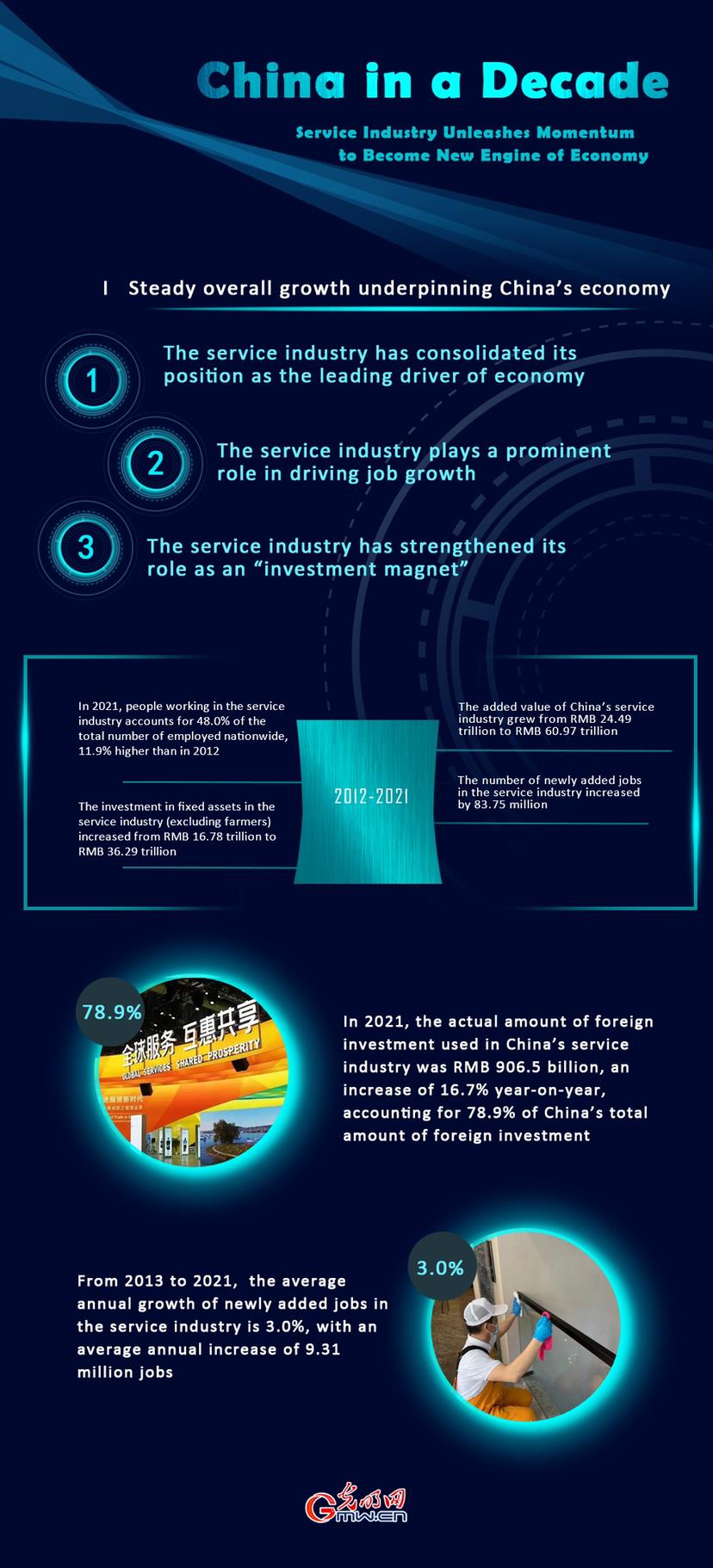

Since the 18th CPC National Congress, the Party Central Committee with Comrade Xi Jinping at its core has attached great importance to the service industry and has launched a series of reform initiatives to improve the quality and efficiency of the industry. Over the past 10 years, the scale of China’s service industry has continued to expand, its structure has been optimized, unleashing new growth momentums while benefiting people’s livelihoods. The industry in the past decade has steadily transitioned from high-speed to high-quality development.
I. Steady overall growth underpinning China’s economy

1. Service industry has consolidated its position as leading driver of economy
(1)From 2012 to 2021, added value of China’s service industry grew from 24.4856 trillion yuan to 60.9680 trillion yuan, with an average annual growth of 7.4% from 2013 to 2021 by constant prices, which was 0.8 and 1.4 percentage points higher than the average annual growth of GDP and the added value of the secondary industry respectively.
(2)In 2020, due to Covid-19, service sectors involving crowd-gathering were greatly affected, and the contribution of the service industry to economic growth dropped to 46.3%, but it still ranked on top of all the three industries.
2.Service industry plays a prominent role in driving job growth
(1)From 2013 to 2021, the number of newly added jobs in the service industry increased by 83.75 million, with an average annual growth of 3.0% and an average annual increase of 9.31 million jobs.
(2)In 2021, 358.68 million people were working in the service industry, accounting for 48.0% of the total number of employees nationwide, 11.9 percentage points higher than in 2012.
3.Service industry has strengthened its role as an “investment magnet”
(1)From 2012 to 2021, investment in fixed assets in the service industry (excluding farmers, the same below) increased from 16.7781 trillion yuan to 36.2877 trillion yuan.
(2)In 2021, the actual amount of foreign investment used in China’s service industry was 906.5 billion yuan, an increase of 16.7% year-on-year, accounting for 78.9% of China’s total amount of foreign investment, an increase of 30.7 % over 2012.
II. Optimized industrial structure underlying coordinated growth

1. Robust modern service industry
In 2021, the value added of information transmission, software and IT services, financial services and leasing and business services accounted for 7.2%, 15.0% and 5.8% of the total value added of the industry, respectively.
2. Industrial integration continues to deepen
(1) In 2021, operating revenues of supply chain management enterprises above designated size reached 132.4 billion yuan, tripling those of 2018.
(2) From 2013 to 2021, average annual growth of operating revenues of human resources service enterprises above designated size reached 18.9%, 7.0 percentage points higher than the average annual growth rate of all service enterprises above designated size.
3. Healthy growth of manufacturing and consumer service industries
(1) In 2020, there were 290,000 enterprises in the manufacturing service industry above designated size in China, employing 26.88 million people, with assets totaling 110 trillion yuan and a total business income of 84 trillion yuan.
(2) In 2020, there were 330,000 enterprises above designated scale in the consumer service industry, employing 28.5 million people, with assets totaling 140 trillion yuan and a total business income of 32 trillion yuan.
III. New dynamics unlocking “new engine” of economy

1. New service entities are bursting with vitality
(1) From 2012 to 2020, the number of legal entities in China’s service industry increased from 7.23 million to 21.66 million, with an average annual growth of 14.7% from 2013 to 2020.
(2) In 2021, the number of newly established enterprises in the service industry reached 7.26 million, accounting for 80.3% of all new enterprises established.
2. “Internet+” stimulates new dynamics
(1) In 2021, mobile internet access hit a total traffic data of 221.6 billion GB, 252 times more than in 2012; internet penetration rate increased from 42.1% to 73.0%.
(2) In 2021, the total volume of e-commerce transactions reached 42 trillion yuan.
(3) Average annual growth of e-commerce hit 20.3% from 2013 to 2021, driving rapid growth of the express delivery industry.
3. New consumption empowers consumption upgrading
(1) From 2015 to 2021, the average annual growth of online retail sales of physical goods reached 25.4%, 17.5 percentage points higher than that of total retail sales of consumer goods.
(2) In 2021, total retail sales of physical goods online accounted for 24.5% of the retail sales of consumer goods in total, up 15.3 percentage points from 2014.
4. Greater openness of the service industry
(1) From 2012 to 2021, import and export of services in China grew from 3.0422 trillion yuan to 5.2983 trillion yuan, with an average annual growth of 6.4% from 2013 to 2021.
(2) In 2021, the import and export of knowledge-intensive services reached 2.3259 trillion yuan, with an average annual growth of 9.3% from 2013 to 2021, its proportion in total service trade increased from 33.6% in 2012 to 43.9% in 2021.
IV. Accelerated growth of the happiness industry delivering better life to people

1. The culture industry
(1) Added value of culture and related industries reached 4.4945 trillion yuan in 2020, accounting for 4.4% of GDP, 0.6 percentage points higher than in 2014.
(2) Among them, added value of cultural service industry hit 2.8874 trillion yuan, accounting for 64.2% of the total added value of cultural and related industries, 15.6 percentage points higher than that of 2014.
2. Construction of the elderly service system has accelerated
(1) As of end 2021, the total number of elderly care institutions and facilities had reached 340,000, with the total number of beds doubled compared to 2012.
(2) Mutual-aid elderly care service facilities have grown from non-existent to over 130,000, providing recreational, catering, and chronic disease management services for the elderly in rural areas.
(3) In the end of 2021, the country’s basic pension insurance had covered more than 1 billion people.
3. Accelerated growth of the sports industry
(1) In 2020, total output of the sports industry reached 2.7372 trillion yuan, with an added value of 1.0735 trillion yuan; of which the total output of the sports service industry reached 1.4136 billion yuan, with an added value of 737.4 billion yuan.
(2) From 2013 to 2021, average annual business revenue growth of sports enterprises above designated size reached 8.4%.
(3) In the end of 2021, the number of sports venues nationwide reached 3.97 million, and per capita area of sports venues reached 2.4 square meters.
4. Public services continue to improve
(1) In 2021, nine-year compulsory education coverage and gross high school enrolment rate reached 95.4% and 91.4% respectively, up 3.6 and 6.4 percentage points over 2012.
(2) In the end of 2021, the number of public libraries and museums in China reached 3,215 and 5,772 respectively, an increase of 139 and 2,703 compared to the end of 2012.
(3) Over the more than two years since the outbreak of Covid-19, China’s vaccination efforts have advanced in an orderly manner, and the nucleic acid testing capacity has improved significantly, building a strong defense line for life. As of end 2021, a total of 2.84 billion doses of Covid-19 vaccines had been administered, and the overall nucleic acid testing capacity had reached 41.68 million per day.

Migrant birds seen at Poyang Lake in Hukou County, China's Jiangxi

Tourists enjoy flowers at Qingxiu Mountain scenic area in S China's Nanning

China Focus: Ancient DNA reveals kinship, social structure of China's prehistoric Shimao city

A glimpse of auspicious creatures on rooftops of ancient architecture in China's Shanxi

点击右上角![]() 微信好友
微信好友
 朋友圈
朋友圈

请使用浏览器分享功能进行分享
